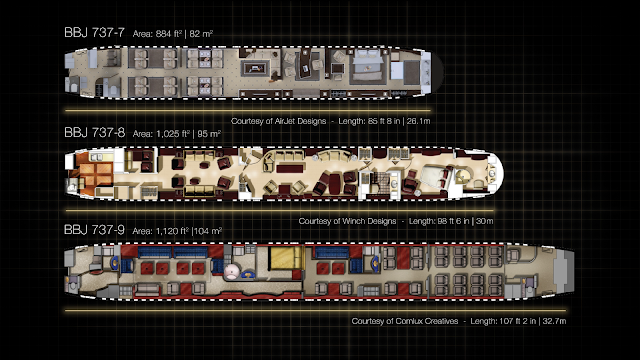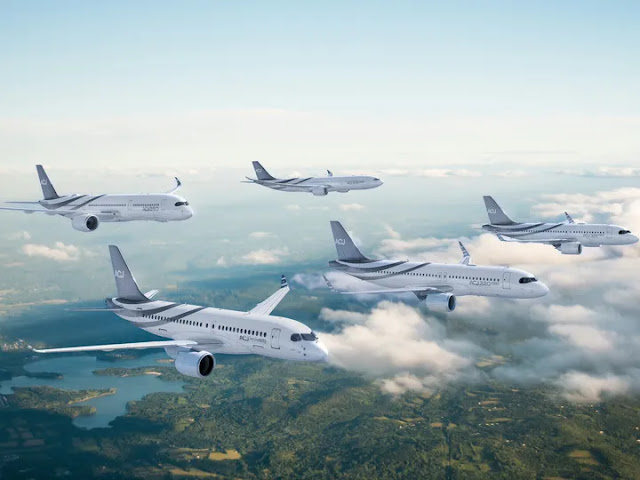With this, the Presidential Aircraft Acquisition Project was included in the Re-Horizon 3 phase priority projects.
 |
| The Airbus Corporate Jets ACJ321neo. Photo credits to Aircharter Advisors. |
Project Summary:
Presidential Aircraft Acquisition Project:
Note: Edited as of 26 July 2025.
* End User: Philippine Air Force (250th Presidential Airlift Wing)
* Quantity: 1 units, plus unspecified subsystems and ILS package
* Modernization Phase: Re-Horizon 3 Phase of RAFPMP
* Project ABC: Php8,813,750,000.00
* Acquisition Mode: Negotiated Direct Contracting
* Source of Funding: Multi-Year Contractual Authority for (X) years, using General Appropriations Act (GAA) from FY2025 to FY200X.
* SARO Release/s: TBA
* Winning Proponent: TBA
* Product for Delivery: TBA
* Contract Price: TBA
* Residual Amount: TBA
* First post by MaxDefense: 15 June 2022
* MaxDefense Searching Hashtag: #PAFPresidentialAircraftAcquisition
* Status: The project was included as part of the Re-Horizon 3 phase of the RAFPMP. The project's Terms of Reference are still being finalized as of 01 July 2025.
Overview:
The acquisition of a presidential aircraft has always been a sensitive issue in the Philippines, as spending billions of pesos on an aircraft that will fly the country's president around seems insensitive when the country has financial issues to pay for social services and needs of the general public.
But what many fail to understand is that, being the President and Commander in Chief of the Armed Forces, the country's leader will need to be able to move around easily, both domestic and overseas, as part of his/her duties. And will also need to be done with high regard to safety, security, and capability to continue managing the affairs of the country wherever may be.
While there have been earlier attempts to procure a presidential of VVIP aircraft, this sensitivity has been a factor, thus the Department of National Defense and the Philippine Air Force previously made efforts to downplay such acquisition.
First, the project was renamed as the "Command and Control Aircraft" which is in fact a basic feature of a presidential aircraft, but the name allows it to downplay and concerns that it was in fact a VVIP aircraft with communications features.
Secondly, the DND and PAF made efforts to reduce the overall cost of such acquisition by selecting a small business jet aircraft capable only of domestic or regional air travel. In fact, the previous acquisition of the Gulfstream G280 as part of the Horizon 2 phase was too downplayed that in the end, the aircraft appears to be too small (the G280 is among the smallest business jets in the market today) to be used as a presidential aircraft for official travels, but only suitable for quick flights within the country.
In the end, the DND and PAF still relies on chartering either larger business jets (as in the recent trip to the United States by President Ferdinand Marcos Jr. for a meeting with US President Donald Trump), or larger medium-long range airlines from Philippine Airlines.
Chartered aircraft usually do not have the extra requirements of a proper presidential aircraft, which includes customized layout to allow for a "flying office", a private room for the president and the first family, as well as lacking in military-spec secured communications equipment that allows for interoperability with existing communication systems of the Armed Forces of the Philippines.
Chartered aircraft are also more suited to passengers in volume, thus the presence of too many economy seats especially for a Government delegation that requires more tables and premium sleep-able seats.
With these capabilities lacking, it has been determined that having a proper presidential aircraft is needed, not just for travels but also for emergency when the high government officials including the president will need to be flown somewhere else for safety while continuing coordination with the rest of the government or the military.
 |
| The BBJ 737 MAX 9. Photo credits to Boeing. |
Procurement Analysis:
Under Re-Horizon 3, a budget of Php8,813,750,000 (roughly US$157 million) was allocated for the procurement of a presidential aircraft.
This budget is, to be frank, very low to allow for the acquisition of a medium or long haul customized VIP aircraft like the Boeing Business Jet BBJ-787 and BBJ-777, and the Airbus Corporate Jets ACJ-330neo and ACJ350.
Instead, the budget might allow for a smaller aircraft like the ACJ319/320/321neo or or the BBJ737 MAX-7/8/9.
Other options may include customized but simpler versions based on the Airbus A320neo or A321neo, or the Boeing B737 MAX 7/8/9 variants.
It will eventually depend on what the specifications require, it there will be a lot of customizations required including the level of luxury features.
If extra space is needed to allow non-VIP additional seating for passengers like media/press personnel, low-level government or military officials,etc., it is best for the consideration of the longer variants which includes the ACJ321neo or the BBJ737 MAX-9.
Both Airbus and Boeing are capable of delivering the aircraft, but it will depend on price, inclusions, support, and probably political reasons as to what aircraft will be selected.
So far, the Philippine Air Force has better relations with Airbus due to the presence of the Airbus-CASA C-295M/W aircraft in its fleet as well as existing support agreements, while there are no Boeing aircraft in the PAF's inventory.
But with the recent meeting of Pres. Marcos and US Pres. Trump, there might be some considerations made to give Boeing an incentive to finally have something for the AFP considering its failure to achieve an order for its offerings which include the F-15EX Eagle II fighter, AH-64E Apache Guardian and AH-6 attack helicopters, CH-47F Chinook heavy lift helicopter, and P-8A Poseidon maritime patrol aircraft.
 |
| Length difference of the BBJ 737-7, 737-8 and 737-9. Photo credits to Boeing Business Jets. |
Both Airbus and Boeing are capable of delivering the aircraft, but it will depend on price, inclusions, support, and probably political reasons as to what aircraft will be selected.
So far, the Philippine Air Force has better relations with Airbus due to the presence of the Airbus-CASA C-295M/W aircraft in its fleet as well as existing support agreements, while there are no Boeing aircraft in the PAF's inventory.
But with the recent meeting of Pres. Marcos and US Pres. Trump, there might be some considerations made to give Boeing an incentive to finally have something for the AFP considering its failure to achieve an order for its offerings which include the F-15EX Eagle II fighter, AH-64E Apache Guardian and AH-6 attack helicopters, CH-47F Chinook heavy lift helicopter, and P-8A Poseidon maritime patrol aircraft.
Boeing also has an advantage considering the Philippines uses mostly American-sourced communications equipment which will make it easier to do with Boeing in terms of technical and political reasons.
Another concern is range. Airbus claims that the ACJ320 has an flying endurance of up to 15 hours or a range of up to 6,750 nautical miles, while Boeing claims the BBJ737 can also have a flying endurance of 15 hours and a range of around 6,600 nautical miles.
This range is enough for the aircraft to fly from Manila to Los Angeles, California at normal cruising/economy speed.
Whatever the selection may be, this would definitely improve the way the Commander in Chief would be flying, with the aircraft good enough to have the callsign "Kalayaan One".
============
U P D A T E S:
============
===============
===============










